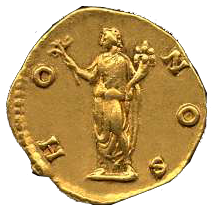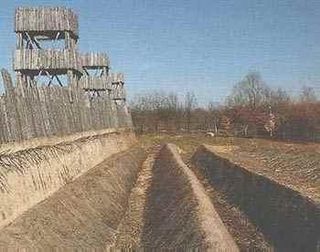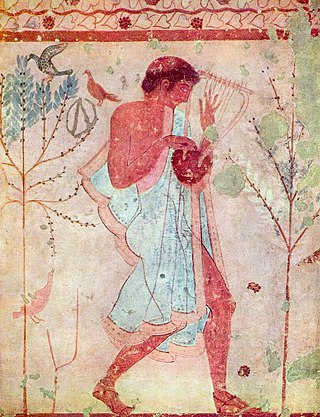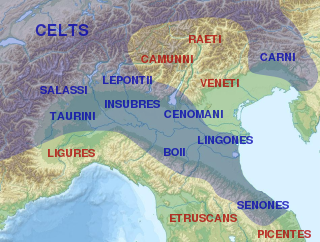
Vercingetorix was a Gallic king and chieftain of the Arverni tribe who united the Gauls in a failed revolt against Roman forces during the last phase of Julius Caesar's Gallic Wars. After surrendering to Caesar and spending almost six years in prison, he was executed in Rome.
This article concerns the period 229 BC – 220 BC.

This article concerns the period 59 BC – 50 BC.
Year 222 BC was a year of the pre-Julian Roman calendar. At the time it was known as the Year of the Consulship of Marcellus and Calvus. The denomination 222 BC for this year has been used since the early medieval period, when the Anno Domini calendar era became the prevalent method in Europe for naming years.

Honos or Honor was the Roman god personifying honor. He was closely associated with Virtus, the goddess of manliness, or bravery, and the two are frequently depicted together. Honos is typically shown wearing a chaplet of bay leaves, while Virtus is identified by her helmet.

Marcus Claudius Marcellus was a Roman general and politician during the 3rd century BC. Five times elected as consul of the Roman Republic. Marcellus gained the most prestigious award a Roman general could earn, the spolia opima, for killing the Gallic king Viridomarus in single combat in 222 BC at the Battle of Clastidium. Furthermore, he is noted for having conquered the fortified city of Syracuse in a protracted siege during which Archimedes, the famous mathematician, scientist, and inventor, was killed, despite Marcellus ordering the soldiers under his command not to harm him. Marcus Claudius Marcellus died in battle in 208 BC, leaving behind a legacy of military conquests and a reinvigorated Roman legend of the spolia opima.

The Battle of Alesia or siege of Alesia was the climactic military engagement of the Gallic Wars, fought around the Gallic oppidum of Alesia in modern France, a major centre of the Mandubii tribe. It was fought by the Roman army of Julius Caesar against a confederation of Gallic tribes united under the leadership of Vercingetorix of the Arverni. It was the last major engagement between Gauls and Romans, and is considered one of Caesar's greatest military achievements and a classic example of siege warfare and investment; the Roman army built dual lines of fortifications—an inner wall to keep the besieged Gauls in, and an outer wall to keep the Gallic relief force out. The Battle of Alesia marked the end of Gallic independence in the modern day territory of France and Belgium.

The First Battle of Nola was fought in 216 BC between the forces of Hannibal and a Roman force led by Marcus Claudius Marcellus. Hannibal was attempting to seize the town of Nola: He failed to do so, and would make two more unsuccessful attempts on the city over the next two years.

The Battle of Clastidium was fought in 222 BC between a Roman army led by the consul Marcus Claudius Marcellus and the Insubres, a Celtic people in northern Italy. Florus writes that the Insubres were led by Viridomarus, or Britomartus, as the name varies in translation. The Romans won the battle, and in the process, Marcellus earned the spolia opima, one of the highest honors in ancient Rome, by killing the king in single combat. It was also notable as one of the few battles won by the Roman cavalry without any aid by the legions.

The second battle of Herdonia took place in 210 BC during the Second Punic War. Hannibal, leader of the Carthaginians, who had invaded Italy eight years earlier, encircled and destroyed a Roman army which was operating against his allies in Apulia. The heavy defeat increased the war's burden on Rome and, piled on previous military disasters, aggravated the relations with her exhausted Italian allies. For Hannibal the battle was a tactical success, but did not halt for long the Roman advance. Within the next three years the Romans reconquered most of the territories and cities lost at the beginning of the war and pushed the Carthaginian general to the southwestern end of the Apennine peninsula. The battle was the last Carthaginian victory of the war; all battles which followed were either inconclusive or Roman victories.

Lars Tolumnius was the most famous king of the wealthy Etruscan city-state of Veii. He is best remembered for instigating, and decisively losing, a war with the neighboring Roman Republic.
The First Celtiberian War and Second Celtiberian War were two of the three major rebellions by the Celtiberians against the presence of the Romans in Hispania.

The Insubres or Insubri were an ancient Celtic population settled in Insubria, in what is now the Italian region of Lombardy. They were the founders of Mediolanum (Milan). Though completely Gaulish at the time of Roman conquest, they were the result of the fusion of pre-existing Ligurian and Celtic population with Gaulish tribes.

The Gaesatae or Gaesati were a group of Gallic mercenary warriors who lived in the Alps near the river Rhône and fought against the Roman Republic at the Battle of Telamon in 225 BC.

Ancient Celtic warfare refers to the historical methods of warfare employed by various Celtic people and tribes from Classical antiquity through the Migration period.

The military campaigns of Julius Caesar were a series of wars that reshaped the political landscape of the Roman Republic, expanded its territories, and ultimately paved the way for the transition from republic to empire. The wars constituted both the Gallic Wars and Caesar's civil war.

Over the course of nearly four centuries, the Roman Republic fought a series of wars against various Celtic tribes, whom they collectively described as Galli, or Gauls. Among the principal Gallic peoples described as antagonists by Greek and Roman writers were the Senones, Insubres, Boii, and Gaesatae.
Lucius Furius Purpureo was a Roman politician and general, becoming consul in the year 196 BC. Lucius Furius was from the gens Furia patrician family in Rome.











